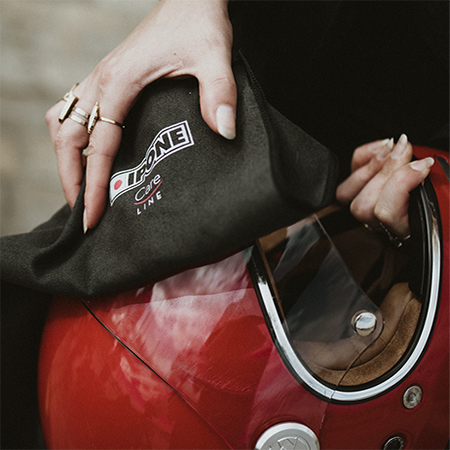99 Motorcycle helmets Available at the best price !
- Rupture de stock
- Discount
Free shipping from 89€.
When you decide to ride a motorcycle, one thing is certain: you need an effective motorcycle helmet. It's the rider's MUST-have equipment, and a must-have for every motorcyclist. There are several sizes and, above all, several types of helmet. Full-face helmets, modular helmets, cross helmets or jet helmets- the choice is yours!

Loading...

All guides & tips



Here are the most frequently asked questions to help you choose your motorcycle equipment, helmet or accessory.
As manufacturers move upmarket, they will multiply the number of caps. What does this mean? Basically, a low-cost helmet has a single XL cap, and then the manufacturer modulates the foam thickness to bring out sizes XS, S, M, L. That's why your wife's helmet is as big as yours. So, inevitably, the higher up the range you go, the more the helmet shell will match your face. It's not so much a question of safety as of cost: each size of skullcap has to pass homologation tests. A skullcap that's better adapted to your face also means greater comfort on long rides (reduced weight and improved aerodynamics).
Smoked screens are forbidden above a certain percentage of obscuration (30%). Below that, they're authorized, but not at night, which makes sense to me. Iridium visors (those where you can see yourself in them like in a mirror) are dead. However, when you buy a helmet with a smoked visor, the seller must provide you with a neutral visor. In my humble opinion, a blackened visor is a luxury for a passenger on the open road. I haven't yet found any use for it other than aesthetic in terms of driving (I've got a double sunscreen for that, much more functional, or even my pair of fake Ray Bans). But tastes and colors...
Dark smoked or iridium screens should normally only be used on the track. You should know that motorcycle helmet manufacturers are starting to offer photochromatic screens or lenses that darken according to the brightness outside.
The 5-year expiration date is a myth. In the 90's, this was a pertinent recommendation, as the paint, which was not UV-treated at the time, would deteriorate and weaken the helmet. Today, as long as you don't fall over, you can ride safely with your helmet.
The best indicator of wear, and the one you need to watch out for, is foam settlement. As soon as your helmet stops hugging your cheeks, you'll need to think about either changing it, or replacing the padding (all brands offer it as a spare part, just like the visor). For the hairy types, you should know that a nice corrosive beard really speeds things up. I've been there. Then, in general, you often tire of your helmet's decoration before you get to the point where the foams are completely flattened...
It's a matter of French pride that we're the only ones in the world to be subjected to this measure. Effective or not? I can't say, but it's compulsory, so... On the other hand, there's some legal uncertainty about dimensions and color. So you can have a bit of fun by giving the stickers a nice shape. But if the dog wants to make you sweat, he'll tell you it's no good. But make sure you have a set of "classic" stickers under your seat, because if they think your helmet isn't fluorescent enough, the police have the right to immobilize your vehicle.
At Ixtem-Moto, we've referenced some black reflective stickers so you don't ruin your helmet's good looks :)
This is a legitimate question for full-face helmets, and I can only advise myopes, hypermetropes, presbyopes and the like (of which I am, alas, one) to check that the helmet in your heart has a passage for your glasses. This will save you a great deal of inconvenience and comfort. Besides, glasses are expensive, so you might as well avoid bending them... At Ixtem Moto, we try to specify this information on the product sheet, and if in doubt, you can come and try on your helmet in our showroom.
Modular or jet helmets pose less of a problem for fitting glasses, but it all depends on your needs.
As ever, there's no such thing as a simple motorcycle. You're not going to get one kind of helmet, but a plethora of possibilities. That said, what's interesting about this product, unlike jackets, gloves, etc., is that one innovation doesn't necessarily replace another, but rather juxtaposes. The "simple" leather jet used by the first bikers is still on the shelves. A magnificent object, complete with a pair of vintage goggles, it is the delight of neo-retro enthusiasts. Except that, while the same look and leather lining are retained, everything else is ultra-protected, with a fiber shell, magnetic fastening system, photochromatic screens, etc. At Ixtem Moto, as at all serious local retailers, you'll find only approved motorcycle helmets.
Full-face helmets
This is the ZE classic. The safest and most secure: there's a reason why you absolutely must have one if you're going to ride on a track. It's also the most suitable for winter weather conditions, since it offers the best coverage. The tricky part is that you'll be able to find one at every price point. A multitude of options, details and choice of materials all play a part in the quality and cost of a helmet.
Jet helmets
We're not going to dwell on this type of helmet. It's the classic we all know. With or without screen, it's a lightweight helmet ideal for urban riding or cruising with your custom or café racer.
Modular helmets
This combines the best of the first two categories. Click and you've got a full-face, click and you've got a jet. If this is the type of motorcycle helmet adopted by the gendarmes, because it offers the advantage of uncovering the face to talk, there's no need to take off the helmet to talk. The quality and weight of the helmet will play a decisive role in this type of product.
In addition, a new range is slowly but surely emerging with the return of the trail spirit: cross-overs. Like our 17-inch-wheeled trailers, they will hide a classic road helmet with visor and company behind an "off-road" look, largely inspired by cross-country models (prominent chin bar, cap).
The cross-country helmet
And then there's the off-road helmet, the pure, the hard, the real thing. For one cross-country lap after another, or one enduro stage after another, you'll need a lightweight, well-ventilated helmet (you'll sweat like hell) with a wide field of vision (so you don't get hit by a branch).
Complement this with a mask. The latter can be more or less adapted to mud, fog and ambient light. But no matter what, it's essential, if only to prevent you from losing an eye to a stupid pebble.
Trial riders will prefer the lightest possible jet helmets, again, with plenty of ventilation. They're almost symbolic, given the speed at which you fall in this discipline (although you often catch the bike on your head), so they need to shine for their small size and wide viewing angle.
The helmet is a safety item that must not be neglected. It's the only thing that can protect your head in the event of a fall. So it's important to choose your helmet with care.
Your motorcycle helmet is the most important part of your riding equipment and protection, and is often a reflection of your personality. That's why Ixtem offers you a wide range of motorcycle helmets for men, women and children, from brands such as Acerbis, Shoei, Scorpion, HJC... All our motorcycle helmets comply with European Community (CE) standards.
First and foremost, it's important to buy a new helmet, and one that fits! Bear in mind that a motorcycle helmet that's too big or damaged won't protect you in the event of a fall or accident. You can come and try them on in our store.
Your riding style : enduro, racing, off-road...
Its certification: To comply with standards, your helmet undergoes numerous tests and trials to guarantee your safety. Today, your helmet must comply with the ECE 22.06 approval standard.
Other criteria and helmet accessories can also be added to help you make your choice: helmet comfort, field of vision, screen, visor or not...
In principle, a motorcycle helmet is supposed to accompany you on the road for many years. But to do so, you'll need to maintain it regularly to ensure its longevity and your safety. No more cracked helmets or helmets that have been dropped several times, even if they appear intact. It becomes dangerous because it's not effective in protecting you.
The motorcycle helmet you choose must be approved (ECE 22.05 standard). This is mandatory, and gives you peace of mind about the quality of your helmet.
The closure of the helmet is also essential. There are 2 types, each with its own advantages.
A new type of fastener is emerging: the magnetic buckle (FIDLOCK). More practical and comfortable, this patented system works perfectly and safely. (The Klim Krios Pro helmet , for example, is equipped with this new system.
At Ixtem, we offer a wide range of rider accessories to enhance your safety. Don't hesitate to ask us for advice.